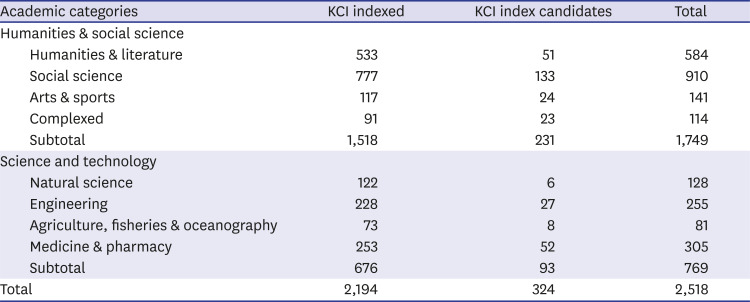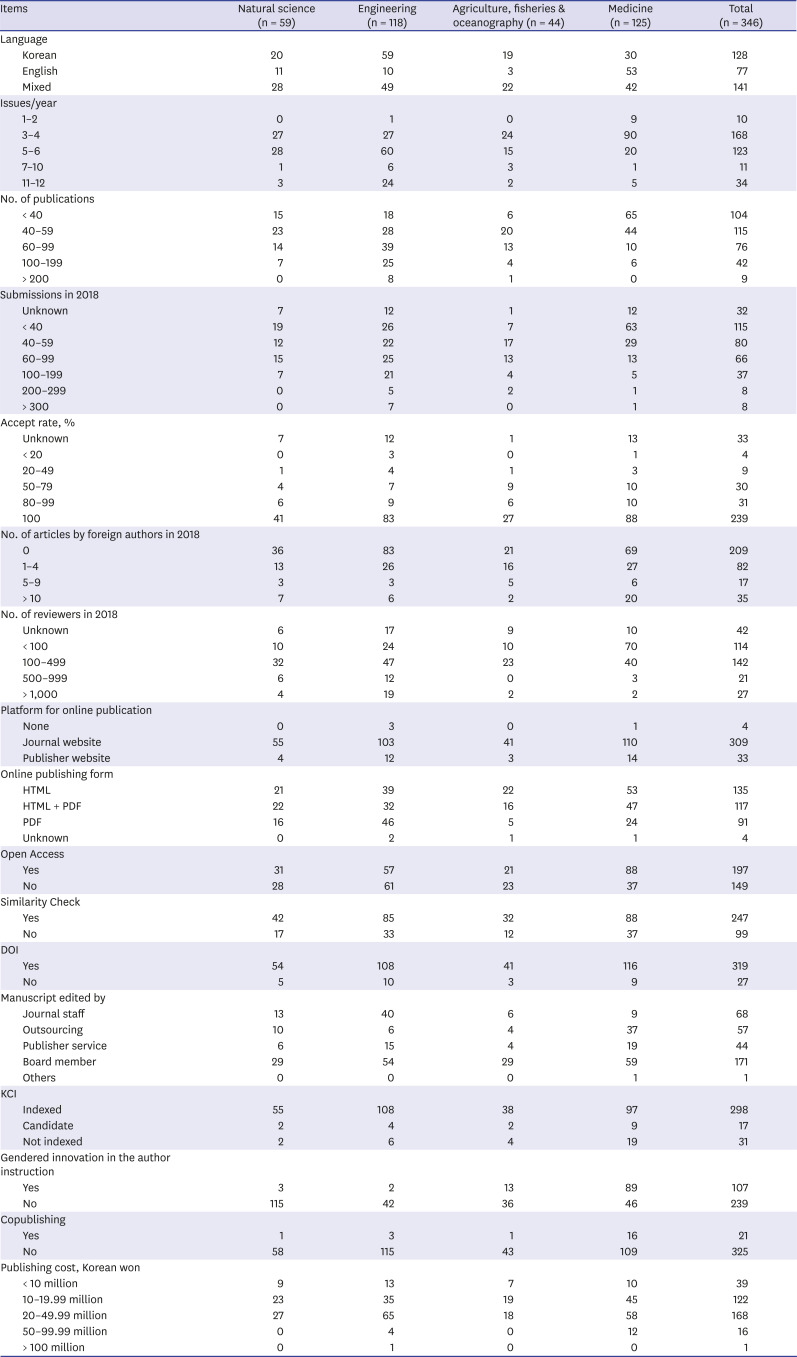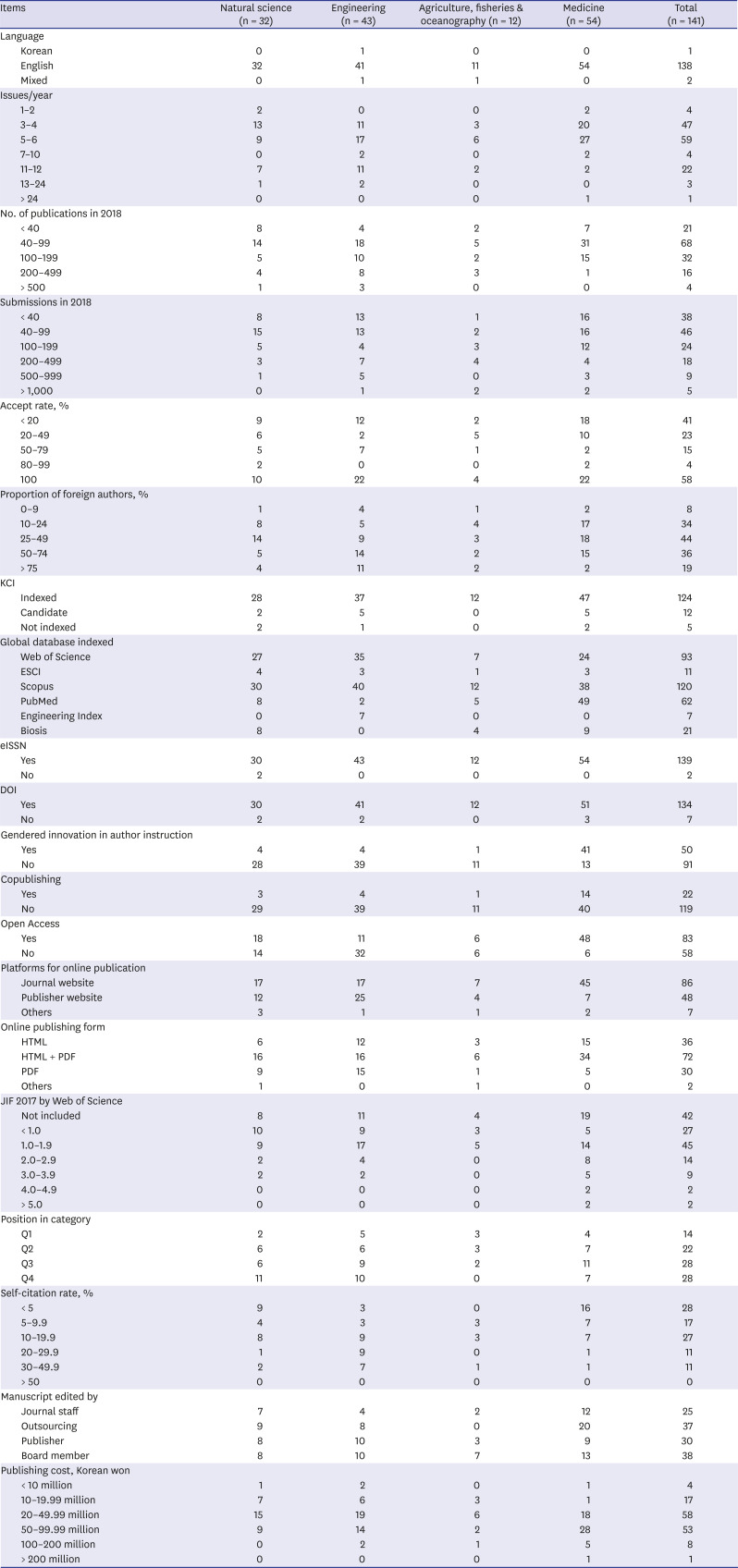INTRODUCTION
Publication of articles in scholarly journals is one of basic activities of scientific research. Therefore, most academic societies publish journals of their own scopes, which must be encouraged for science progress. In the journal database of the Korea Research Foundation, 5,630 journals are registered, but only 2,194 of them are Korea Citation Index (KCI) indexed and 324 index candidates.
1
The Korean Federation of Science and Technology Societies (KOFST) is an organization to enforce academic activities of science and technology societies in Korea, which are categorized natural science, engineering, agriculture, fisheries & oceanography, medicine & pharmacy, and complexed sciences.
2 The KOFST plays many roles of supporting or boosting academism in science and technology categories by several programs. One of the KOFST programs is financial support for journal publication by academic societies, which is grouped for regional, international, and pre-international journals. The international journals are indexed ones in the Web of Science or Scopus and the regional journals are those not indexed by either of the 2 global databases.
2 The journal supporting program selects 70%–80% journals among the applicants after peer review and supports < 50% of publication cost with limitation of 40,000,000 won. A peer review system is established and announced through the website of KOFST. The journal review system is composed of 5 essential and 9–10 grading items which represent editing or publishing quality and scientific contribution.
3
To overview journal publishing status and quality, the present study analyzed publishing and editing status of scholarly journals of science and technology in Korea.
Go to :

DISCUSSION
Most of Korean scholarly journals which applied the KOFST program are enlisted on the KCI as indexed or index candidates. A total of 2,518 journals are KCI enlisted by January 23, 2020, and 1,749 are in category of arts & humanities and social science while 769 are in science and technology (
Table 1). There may be more journals unlisted by the Korea Science Foundation but it is hard to estimate exact numbers. In a word, numerous and diverse scholarly journals are published by Korean academic societies, which suggests active research and academic publication activities. However, most of them are rather small according to divided specialties, especially in the category of arts & humanities and social science. Publishing too many small journals is eventually linked to sustainability problems by insufficient submissions and financial shortage. We have to consider seriously how to co-publish journals of related scopes to keep their critical mass.
Only one-third of the KCI enlisted journals are in the scope of science and technology, total 769. Of the 769 journals, only 487 applied the review process by KOFST in 2019. Most of the remaining 282 journals may not meet the basic criteria of the application, such as timely publication, well-established peer review system, well-prepared instruction or guidelines for contributors, open display of basic publishing information, and global publication networking by DOI.
2 Of the 487 applied journals, 346 applied regional, and 141 international journal programs (
Table 2). The numbers of journals were more in engineering and medicine than those in natural science, agriculture, and fisheries & oceanography, which suggest that numbers of academic societies and researchers are more in the engineering and medicine than those in other science fields.
Regional journals publish articles mainly in Korean, which means they target Korean audience. All of the articles in Korean were published in Korean text with English title, authors and affiliations, abstract, tables, figures, and references following global guidelines for non-English journals. Contrary to this, all of international journals published English articles except one. Only one is published in Korean but indexed by the global databases. Most of the regional journals were small and received insufficient submissions, and thus their accept rates were rather high. Many of 141 international journals were small either, but 26 of them published 12 or more issues and 20 published over 200 articles in 2018. Those journals received many submissions including overseas submissions and contributed much to global science.
Four regional journals had no platforms for online publication, which means they published offline (paper-print) only. However, all of other regional or international journals provided platforms at journal specific websites or at publisher's websites. Some of them were online only but most of them were both offline and online journals. A total of 197 (56.9%) regional journals were OA, but medical journals showed higher proportion (70.4%) while OA journals in 3 remaining category journals were around 50%. This pattern of OA was same in international journals, 83 (58.9%) of 141 journals were OA with 48 (88.9%) of 54 medical journals. In Korea, most of medical journals are OA but those in other categories are not. Medical journals publish more English articles with OA than those in other scopes, and this means that most of medical journals even regional journals intend to target global audience. All of the OA journals displayed CC-BY or CC-BY-NC (
https://creativecommons.org/licenses/by/4.0/) following the Creative Commons' recommendation which is global norm of OA.
Being indexed in journal databases is critical for scholarly journals. Of the 346 regional journals, 31 were not, and 5 of 141 international journals were not indexed in the KCI, the national journal index in Korea. The present KCI index data suggest that most of the applying journals for KOFST review are indexed and officially endorsed for proper management of editing and publishing practice. The 141 international journals were indexed either by the Web of Science (93 journals) or Scopus (120 journals). The highest JIF in 2018 was 5.571 by the
Journal of Stroke, which is published by the Korean Stroke Society. By the JIF, most of the journals were distributed between 1.0 and 2.0 and in the position at Q3 or Q4 among indexed journals in their scientific specialties by the Web of Science (
Table 4). To raise the JIF and the position of journals in their categories, journals must be more reader friendly and invite more good quality articles with academic impacts. Many international journals have established stable system of editing and publishing to invite global authors and readers. They are upgraded slowly and steadily. One medical journal,
Journal of Korean Medical Science (
JKMS), which is published by the Korean Academy of Medical Sciences, is published weekly.
4 The journal publishes about 300 articles a year and is indexed by the KCI, Web of Science, Scopus, and PubMed. It plays the role of flagship journal for editing and publishing in Korea. In the ongoing period of coronavirus disease 2019 (COVID-19) pandemic,
JKMS is publishing many articles on COVID-19 by rapid editing, mostly within one week from submission.
Manuscript editing (ME) is a final process of editing or revising of accepted manuscripts, which includes keeping formats, correcting typographic errors, grammars, or any required amendment before publication. This final ME is important for quality publication but it is a tedious technical process. It is ideal for journals to perform ME by well-trained professional manuscript editors, either as journal staff or via service company. In about half of the Korean scholarly journals, editorial board members are responsible for this ME process, but this is not a job of the editorial board members. The academic societies that publish scientific journals must exempt editorial board members doing ME. The board members should focus on contents of manuscripts by reviewing, selecting, and ensuring science. This is the priority for public financial supports to upgrade journals.
The SAGER guideline for gendered innovation was published in 2016 and has been recommended to all biomedical journals.
5 The guideline was accepted by the International Committee of Medical Journal Editors (ICMJE) and included in the ICMJE Recommendations.
6 The recommendation is to design the research to minimize gender or sex influence by subjecting equal number of humans, animals or cells of different sex or gender as possible. The articles should clearly document subject numbers by sex, which is responsible for all journals that publish research articles subjecting humans, animals, or cells. The present analysis confirmed that many Korean journals did not document the gendered innovation guideline and most of published articles did not describe it. A total of 107 (30.9%) of regional journals and 50 (35.5%) of 141 international journals documented this guideline in their instruction to authors. Most of them were medical journals, 89 (71.2%) of 125 regional and 41 (75.9%) of 54 international journals. Only 5% journals in natural science, engineering, and agriculture, fisheries & oceanography documented it. It is strongly recommended to accept it in editing and publishing for all journals which publish articles on humans, animals, or cells.
Summarizing the journal publishing, most of the Korean science and technology journals keep their global standard editing and publishing by both offline and online. Their online visibility is acceptable but most regional journals are small and of low academic impact while many international journals are globally indexed and acknowledged. Korean journals should invite more and better articles to keep quality publication. Research societies and the government must stop more credit policy for publications in high impact factor journals to evaluate researchers.
Go to :








 PDF
PDF Citation
Citation Print
Print





 XML Download
XML Download